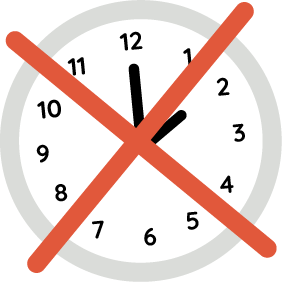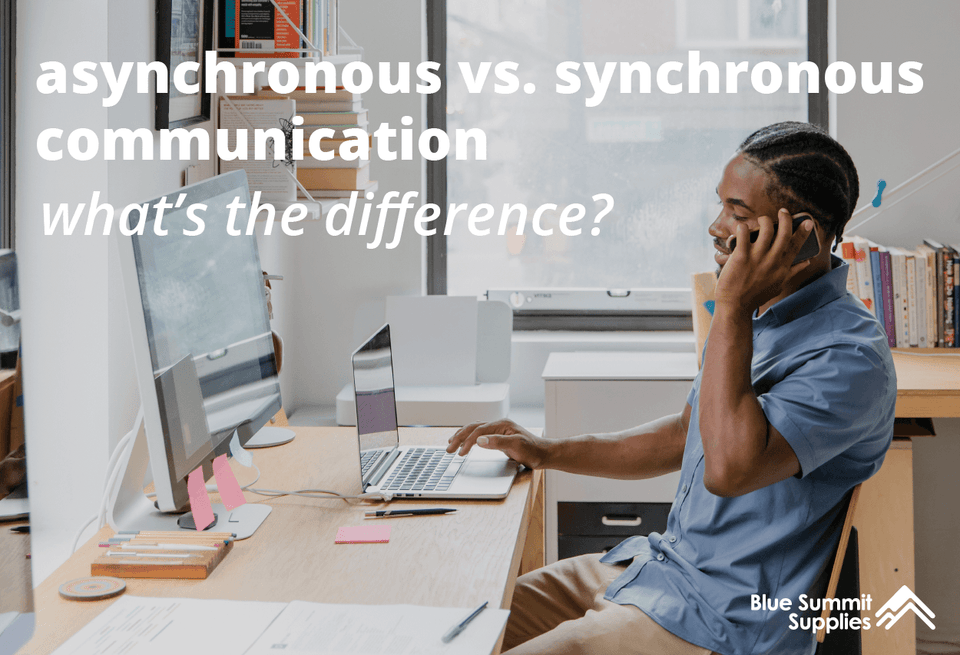If you’ve been hanging around an office lately, virtual or otherwise, you may have heard some conversations around the benefits and drawbacks of asynchronous vs. synchronous communication. But what does asynchronous communication mean? Is it another one of those productivity buzzwords like ‘synergy’ or ‘incentivize’ or ‘freemium?’
Don’t worry. While it sounds complicated, the definition is a simple one. In this post, we’ll define asynchronous communication, share asynchronous examples, discuss the difference between synchronous and asynchronous communication, and provide tips for successfully communicating in both ways.
Asynchronous vs. Synchronous Communication
So, what is the difference between asynchronous and synchronous communication, and why does it have to sound so complicated? If you’ve had to google “asynchronous meaning,” you’re not alone. But it’s really a lot more simple than it sounds.

Synchronous communication is any communication that occurs in real-time. A conversation you have with a coworker in the office is an example of synchronous communication. Having a conversation on the phone is another example.

Asynchronous communication is any communication that does not occur in real-time, such as an email or when you leave someone a message on the phone. When you send someone an email, you don’t expect them to get back to you immediately. You understand that they’ll get back to you at their earliest convenience.
Examples of synchronous communication:
- Phone calls
- Speaking in person
- In-person meetings
- Slack conversations
- Zoom calls
- Video conferencing
- Facebook messenger conversations
Examples of asynchronous communication:
- Phone voicemail messages
- Text messages
- Slack messages
- Physically mailed letters
You might notice that there’s some overlap between what’s considered synchronous vs. asynchronous. That’s because the distinction comes from how the communication medium is being used.
A live back-and-forth conversation over Slack is considered synchronous communication. If, however, you send a Slack message to a colleague who takes a look at it later in the day at their convenience, this is considered asynchronous communication.
The same is true for any mode of communication that can happen live and in the moment, such as Facebook messenger, text messages, Zoom messages, etc. If you’re speaking back-and-forth with direct, live communication, the communication is synchronous. If you send messages that are not looked at and responded to the moment you send them, the communication is considered asynchronous.
Synchronous and Asynchronous Communication Strategies
Distinguish Between Synchronous vs. Asynchronous Communication
The very first step in improving your communication is understanding when to choose which type of communication style. There is a time and place for both asynchronous and synchronous communication, and a workplace can’t function optimally without both working hand-in-hand. The key is understanding when to use each form of communication.
Optimal time for synchronous communication:
- Team meetings
- One-on-one meetings
- Daily stand ups
- Urgent questions
- Emergencies
- Client meetings
- Brainstorming sessions
- Team problem solving
- Team building activities
- Lunch and learns
- Elevator or water cooler talk
- Events
- Conferences
- Networking
Optimal time for asynchronous communication:
- Non-urgent questions
- Inquiries
- Check-ins
- Salutations
- Daily progress reports
- Reminders
- Booking time off
- Scheduling meetings

We all have natural communication styles and preferences that we lean towards, but everyone is different, and each situation is different. Step outside of your natural communication style and take time to consider the best course of action before you communicate.
Do you need an answer immediately? Is it an emergency? Will you interrupt the person you are communicating with if you reach out and attempt to communicate synchronously? Are you able to answer the question yourself? Could you save your question for your upcoming meeting? How long has it been since you last had an in-person or live conversation?
Whether you’re an adult, a toddler, a dog, or a cat, you want instant gratification. Nobody likes to wait! But this need for instant feedback comes at a cost for ourselves and those around us. When we reach out and expect an immediate answer, we are interrupting the other person or people we are communicating with. In order to receive a direct, synchronous response, that person needs to stop whatever they are doing to communicate with you at that moment.
By simply stopping to consider whether or not the interruption is worth it, you place more value on other people’s time. What’s the best mode of communication for what you have to say?

Batch Synchronous Communication
There are plenty of times when synchronous communication is much easier. But you can make the most of synchronous communication without infringing on other people's time by batching what you have to say and saving it for specific, ideal moments, such as check-in meetings or one-on-ones.
Keep track of all of your comments, feedback, concerns, and questions in one organized location, so you can continually add to your list of topics in between meetings and save them for ideal communication opportunities. A one-on-one meeting agenda is perfect for this, but if you don’t have regular one-on-one meetings, choose another location to store your list of ongoing notes, such as a Google Doc or in a physical notebook.
A batching method is also useful for asynchronous communication. Instead of sending an email or Slack message the next time you have a question, store that question until you have a few, and send either one daily or one weekly message that includes multiple items. This will help you stay organized, and it will prevent you from overflowing your colleagues’ or manager’s inbox.

Do What You Can Before You Ask
Put more effort into solving your own problems before interrupting someone else’s workflow. They may have the answer, but are you able to figure it out yourself if you take some more time to think about it?
Anything that’s Google-able is not worth messaging a team member about. If you can look it up yourself, do so. Where else could you find the answer to your question? Has your question already been asked by someone else? Might you find your answer in your company’s handbook or by searching previous Slack messages?
Exhaust all options before reaching out and using up someone else’s time.

Manage Your Own Notifications
As much as you can improve your own communication processes, you can’t control those around you. Your colleagues may still be learning about the benefits and drawbacks of synchronous and asynchronous communication, so be patient—and manage your own notifications.
Slack, email, texts, and other messaging platforms can all interrupt you if you allow them to. Take time to update your notification settings so that you cannot be interrupted at all hours of the day. Update your preferences on your computer, phone, and any other devices that send live notifications, such as tablets, smartwatches, and Fitbits.
Don’t forget about your inbox. How many times do you check your email every day? Do you reply to each email as you receive them? Do you turn to your email whenever you want a break from your other work? Do you use your email as a distraction from your real work? Do you check your email even when you’re not technically supposed to be working?
Email is a form of asynchronous messaging, so no one is expecting an immediate reply back. To best optimize your own time, schedule specific times during the day to check your email. If you’re an avid email checker, start by scheduling a few times every day and slowly pare that down to only once or twice a day.
💡 Learn more in our guide: How to Manage Notifications and Reduce Distractions at Work.

Set Clear Best Practices Around Workplace Communication
Don’t leave your workplace communication processes to guesswork. Set clear best practices and guidelines for all team members to follow so that there’s no confusion across teams or across your organization.
Are there any specific times during the day that all team members need to be available? What is the best method for contacting team members? What resources are available to help employees find the answers they need themselves? Is it better to message colleagues via email, Slack, or another platform?
Compile communication best practices, including how to choose between synchronous and asynchronous communication, in one easy-to-access location. Continue to add to it as you learn more about how your team prefers to communicate. Ensure that all new hires familiarize themselves with your company’s communication processes.
Strategies for Better Communication
💡 7 Actionable Strategies for Better Communication in the Workplace
💡 Transparent Communication in the Workplace
We’re passionate about workplace communication and wellbeing. Follow our office supplies blog for the latest trends, office strategies, product comparisons, and more.
Reach out to us with questions or comments any time, by email, in the comments below, or on Twitter, Facebook, or Instagram.
 For more informative articles about office supplies, subscribe to our email newsletter!
For more informative articles about office supplies, subscribe to our email newsletter!
Never fear, you won't begin receiving daily sales emails that belong in a spam folder. Instead, we promise a fun weekly roundup of our latest blog posts and great finds from across the web. And if you lose interest, it's always easy to unsubscribe with a single click.










